Dyson is no stranger to incrementally improving its product line.
In this week’s comparison review we’ll look at the Dyson V7 vs. V8 and see how they stack up.
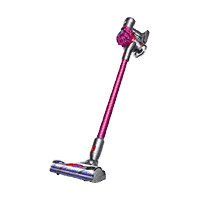
- Max Suction: 100 AW
- Run Time: 30 minutes
- Recharge: 3.5 hours
- Dustbin: 0.53 L
- Weight: 5.45 lbs
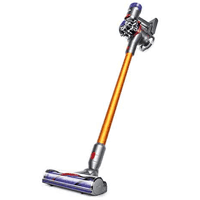
- Max Suction: 115 AW
- Run Time: 40 minutes
- Recharge: 5.5 hours
- Dustbin: 0.53 L
- Weight: 5.8 lbs
Dyson V7 vs. V8: What’s the Difference?
The primary difference between the V7 and V8 is suction power and battery life. The Dyson V8’s more powerful motor can generate 115 AW of suction, while the V7 generates 100 AW of suction.
Additionally, the V8 can run for up to 40 minutes compared to the V7, which runs for 30 minutes.
Rather watch a video than read a review? See our Dyson V7 vs. V8 video review below.
Cleaning Tests
The following vacuum cleaner tests are designed to show how the Dyson V7 and Dyson V8 perform on different surfaces, picking up a variety of debris types.
We test on three different floor types, including hardwood floors, low pile carpet, and high pile carpet.
Overall Cleaning Scores
Dyson V7
89%
Dyson V8
95%
Dyson V7 Cleaning
Hardwood
67%
Low Carpet
100%
High Carpet
100%
Dyson V8 Cleaning
Hardwood
89%
Low Carpet
99%
High Carpet
98%
Hardwood Floor Cleaning Tests
The performance differences between the Dyson V7 vs. Dyson V8 were certainly noticeable when it came to our hardwood floor tests. The Dyson V7 struggled more so than the V8, simply due to the head of the vacuum pushing the cereal around the testing lane in addition to flinging the rice.
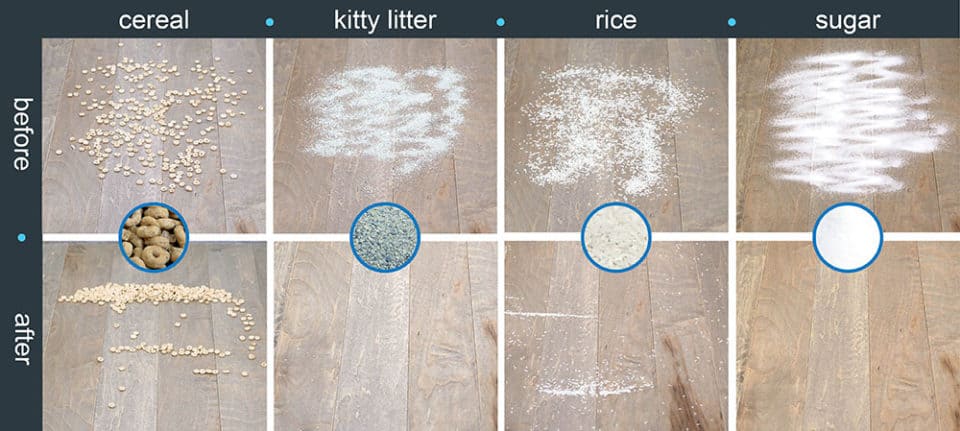
The V8 also struggled on the cereal test, but not to the degree of the V7. Rice was no issue for the V8 as it was able to clean up 99% whereas the V7 was only able to clean up 66% of the rice.
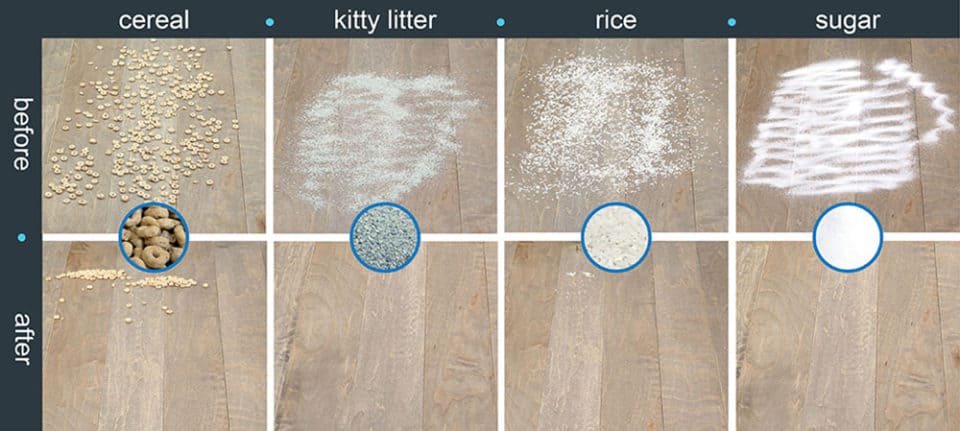
All that said, it should be noted that we used the Direct Drive cleaning head for both the V7 and V8 on these tests (since we did not have the soft roller head). Had we had the soft roller head available we suspect both would have performed much better.
In order clean larger debris like this in a real-life setting, you’d likely need to use the fluffy cleaning head or an attachment like the dusting brush or crevice tool.
Low Pile Carpet Cleaning Tests
The low pile carpet cleaning tests proved to be much less of an issue for both the V7 and V8. Each of these vacuums were able to clean up all four debris types to a level of 99% or higher.

Both of these Dyson vacuums showed a strong degree of suction and were able to roll over all four debris types with ease as they sucked them up.
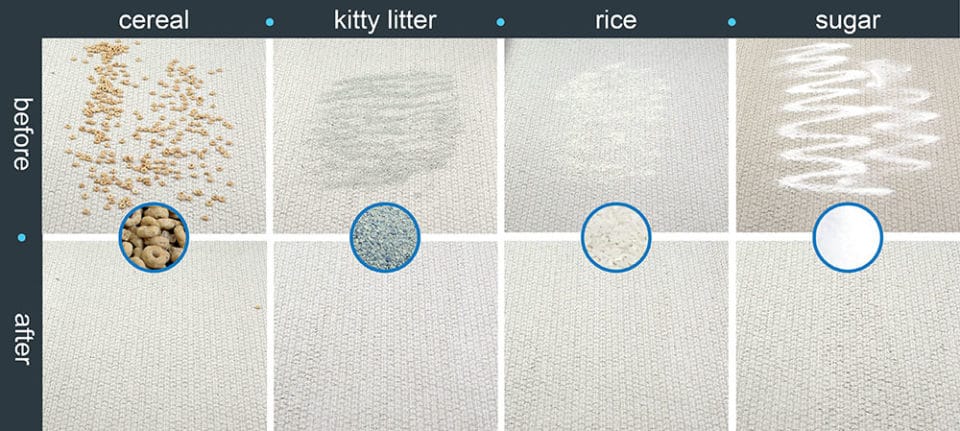
High Pile Carpet Cleaning Tests
The Dyson V7 and V8 were virtually flawless on the high pile carpet test. Once again, all four debris types were cleaned up to a level of 99% or higher.
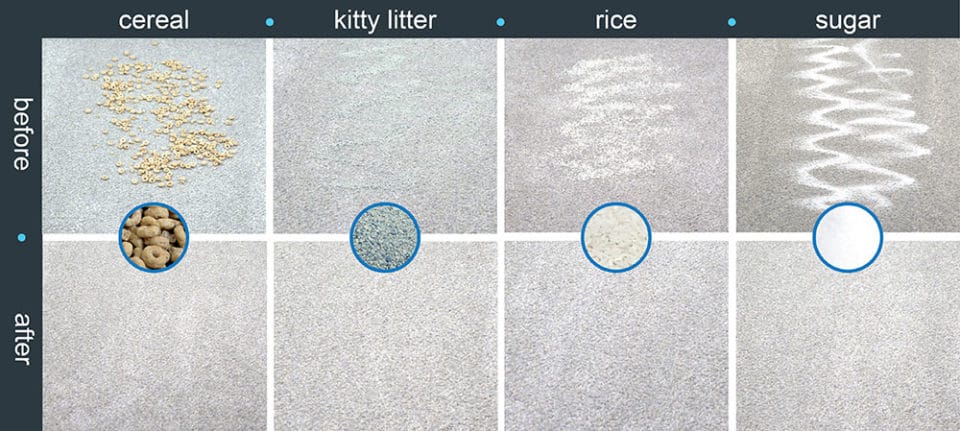
Neither vacuum struggled on the high pile carpets.
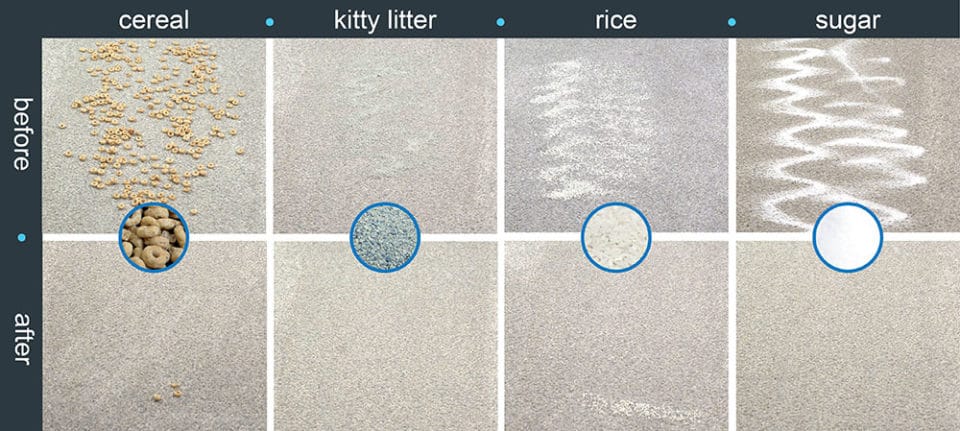
For our comprehensive testing data see our full Dyson V7 review and Dyson V8 review.
Dyson Run Time: V7 vs. V8
According to Dyson, the V7 has up to a 30-minute run time and the V8 has up to a 40-minute run time.
We decided to put these claims to the test and see for ourselves just how long these vacuums could go for.
Here were our findings:
Dyson V7
(in minutes)
- Normal Mode: 27:45
- Max Mode: 7:10
Dyson V8
(in minutes)
- Normal Mode: 31:40
- Max Mode: 8:20
**All run-time tests were completed with the Multi-Surface cleaning head.
During these tests, the V7 ran about as long as expected (less than 3 minutes of difference between Dyson’s estimated max run time and the actual max run time.
It is worth noting that Dyson’s run time estimates are based on using a non-motorized handheld attachment, and not the Direct Drive / multi-surface brushroll like that we did.
Design Differences
As mentioned above, suction and run time are the two largest players in what separates the V7 from the V8. The Dyson V8 has a more powerful motor that can generate 115 AW of suction, while the V7 generates only 100 AW of suction.
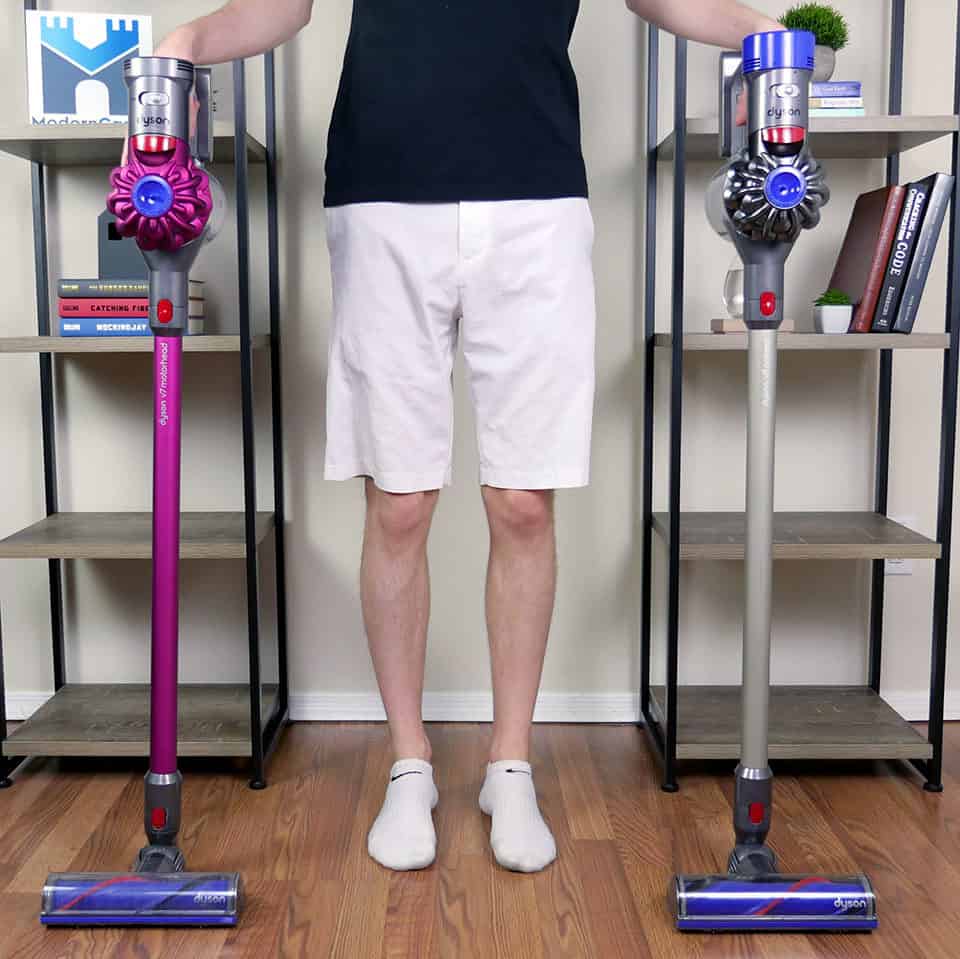
Additionally, the V8 can run for up to 40 minutes compared to the V7, which runs for only 30 minutes. The Dyson V7 offers an aesthetic extremely similar to the Dyson V8. Both utilize the three part design with a wand, cleaning head, and handheld base.
Each of these pieces serves a different function, but they are virtually identical when it comes to comparing the V7 and V8.

Color schemes vary between these two models. Dyson does not offer the same color pallet for the V7 and V8.
As a company, it intentionally kept the colors different between the two models to ensure there is less confusion between them.
Dyson V7 Model Variants
The V7 comes in four different models:
- Dyson V7 Animal – The Animal includes a few different accessories, but the primary “animal” accessories are the motorized brushroll and mini motorized brushroll.
- Dyson V7 Motorhead – This is the most budget-friendly version of the V7, only including a crevice tool and combination tool.
- Dyson V7 Absolute – The V7 Absolute comes with a plethora of accessories. The main accessory that is unique to this model is the soft roller head.
- Dyson V7 HEPA – This Dyson V7 offers a few accessories, but the biggest distinction is in the filter. This V7 includes a HEPA filter on the back of the vacuum.
Dyson V8 Model Variants
The Dyson V8 is available in the Absolute and Animal version.
- Dyson V8 Absolute – Includes all accessories in addition to both the Direct Drive cleaning head (multi-surface) and fluffy soft roller cleaning head for hard floors
- Dyson V8 Animal – Only includes the Direct Drive cleaning head (multi-surface), but still includes most the same accessories as the V8 Absolute.
How the Dyson V7 & V8 Clean
Both the Dyson V7 and V8 continue to use Dyson’s patented radial cyclone design. These two Dyson stick vacuums also utilize the original cyclone design first seen on the Dyson V6.
Each of these units has the radial cyclones stacked on top, or perpendicular, to the dust bin. Although this design is a bit less streamlined than the newer Dyson V10, the suction power and performance is still quite impressive.
Cleaning Heads
Another similarity shared between the V7 and V8 is their cleaning heads. While we only received the Direct Drive head for each unit, both of them have the option to add a soft-roller cleaning head, depending on the model you select.

There are four different V7 models available, but the V8 is only offered as the Animal and Absolute (in the US).
The Direct Drive head is powered by the motor when the trigger is pulled and allows the brushroll to spin, agitating dirt and debris while sucking it up.
The V8’s head is a bit larger in terms of height, which definitely helps when it comes to picking up larger debris.
RELATED – Want the absolute best performance Dyson can offer? See our Dyson V11 Outsize review and Dyson V11 review.
If you select a model with a soft roller head, keep in mind that it is best suited for hard floor surface types and larger debris types. The softer pad does a nice job of rolling across your floors without scratching them.
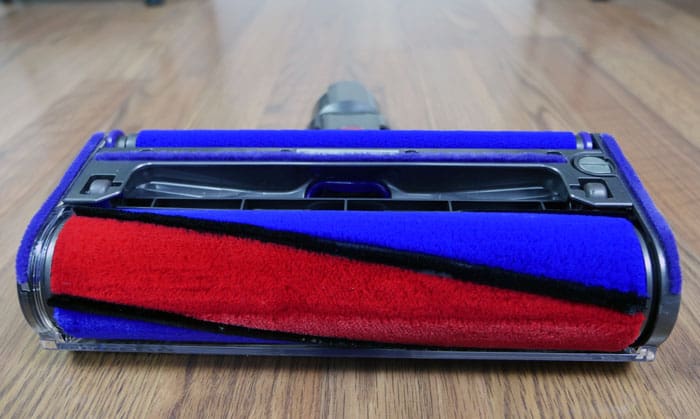
MORE: For comparison, here is a view of the Fluffy cleaning head that comes with the Dyson V10. The fluffy head for the V7 and V8 is nearly identical to this.
2-in-1 Design
Each of these Dyson vacuums can be used as a stick or a handheld. Swapping between the two styles is as simple as the click of a button.
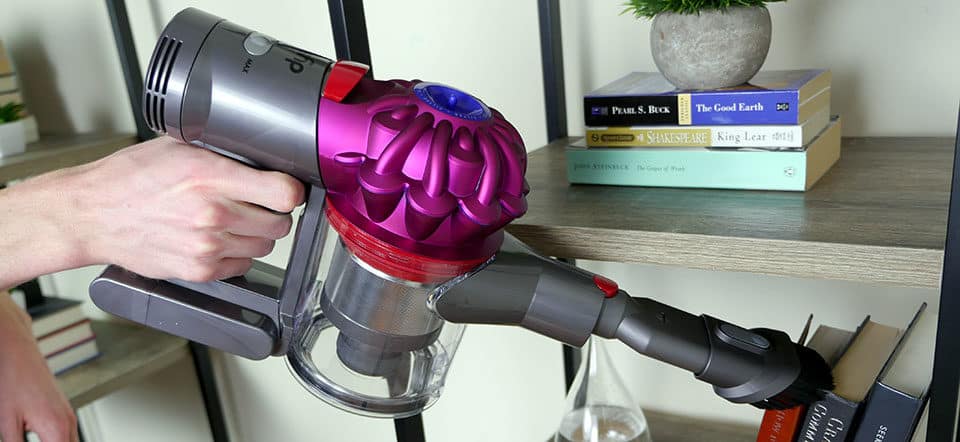
Simply insert the wand into the quick release point on the main unit to use the V7 or V8 as a stick, or insert one of the included cleaning tools directly into the quick release point to use them as handhelds.
Size & Dimensions
The Dyson V7 stands at 49″ tall and is 9.8″ wide. Additionally, this vacuum weighs 5.45 pounds.
This is just a touch shorter than the Dyson V8, which totals 49.2″ in height. That said, they are the same width at 9.8″ wide. The V8 does weigh a bit more as well, bringing home a total weight of 5.75 pounds.
Although the V8 is a little heavier than the V7, the difference is not enough to significantly affect the maneuverability of the vacuum.
Dyson V7 Size
- Height: 49″
- Width: 9.8″
- Depth: 8.2″
- Weight: 5.45 lbs.
Dyson V8 Size
- Height: 49″
- Width: 9.8″
- Depth: 8.8″
- Weight: 5.75 lbs.
Accessories & Parts
Please note, the following table indicates the parts and accessories that are included on the most popular available versions of both the Dyson V7 and Dyson V8.
| Accessory | Dyson V7 Motorhead | Dyson V7 Animal | Dyson V7 Absolute | Dyson V8 Animal | Dyson V8 Absolute |
|---|---|---|---|---|---|
| Wand | Yes | Yes | Yes | Yes | Yes |
| Charger | Yes | Yes | Yes | Yes | Yes |
| Wall mount | Yes | Yes | Yes | Yes | Yes |
| Soft roller cleaning head | No | No | Yes | No | Yes |
| Direct Drive brushroll | Yes | Yes | Yes | Yes | Yes |
| Combination tool | Yes | Yes | Yes | Yes | Yes |
| Crevice tool | Yes | Yes | Yes | Yes | Yes |
| Dusting brush | No | Yes | Yes | Yes | Yes |
| Mini-motorized tool | No | Yes | Yes | Yes | Yes |
Each of these vacuums have a model that includes both the soft roller head and a direct drive (motorized brushroll) head.
Be sure to double check that the model you are interested in has the appropriate cleaning head(s). The differences between these two heads are:
Direct Drive Cleaning Head
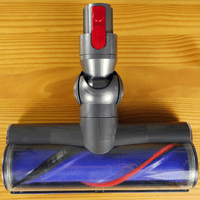
Standard cleaning head with a motor-driven rotating brushroll. Works on all floor types (ideal for carpets though)
Soft “Fluffy” Cleaning Head
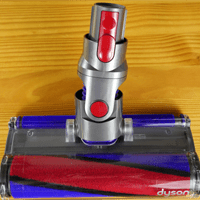
Soft rotating brushroll—ideal for hardwood floors and other hard surfaces, also great at picking up larger debris. If you have 30% or more hardwood floors it’s worth getting a version that includes the soft roller head (or buy standalone here).
In addition to the different cleaning heads, here’s a rundown of the other parts and accessories with these Dysons:
Wand
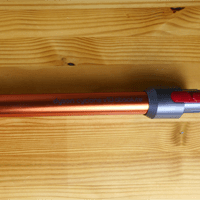
Can be used to create a stick vacuum or in the handheld configuration, adding length and versatility to the unit as a whole
Charger
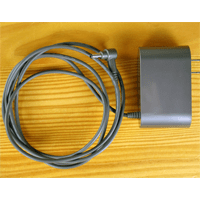
Plugs directly into the wall and your vacuum to charge the battery
Wall Mount
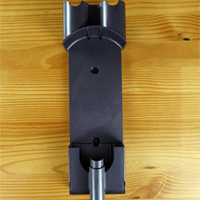
Allows you to hang the vacuum on your wall
Crevice Tool
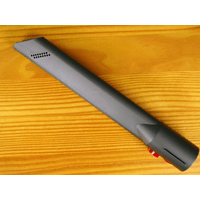
Gives you access into tighter and hard to reach corners and crevices
Combination Tool
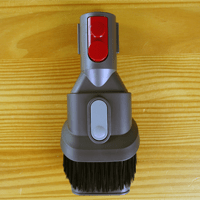
Acts as a dusting brush and upholstery cleaning tool
Dusting Brush
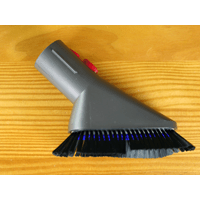
Soft bristles dust more delicate surfaces around your home while also vacuuming
Mini-Motorized Brushroll
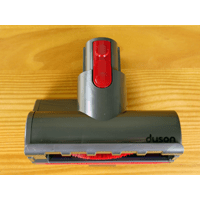
As a smaller motorized brushroll, users can attach this tool t help lift pet hair off of surfaces inside the home
Using the V7 & V8
Unboxing
The unboxing process for both the V7 and V8 is simple, but can take a few minutes to complete. Dyson wraps each piece individually; therefore, you have to pull each part out of its wrapper before assembling each vacuum.

Setup
Once you move into setup, the main piece of the puzzle is charging each vacuum. The Dyson V7 and Dyson V8 is assembled by snapping in the wand or tool you’d like to use.
RELATED – Can it get easier than not having to vacuum at all? Robot vacuums can do the vacuuming for you. Check out a couple of our favorites, including the Roomba S9+ and Roborock S6 MaxV.
Daily Use
With regard to using these vacuums on a daily basis, the V7 and V8 utilize the trademark Dyson trigger used by all of the V-series vacuums. The trigger applies power to the motor and once released, shuts the power off.
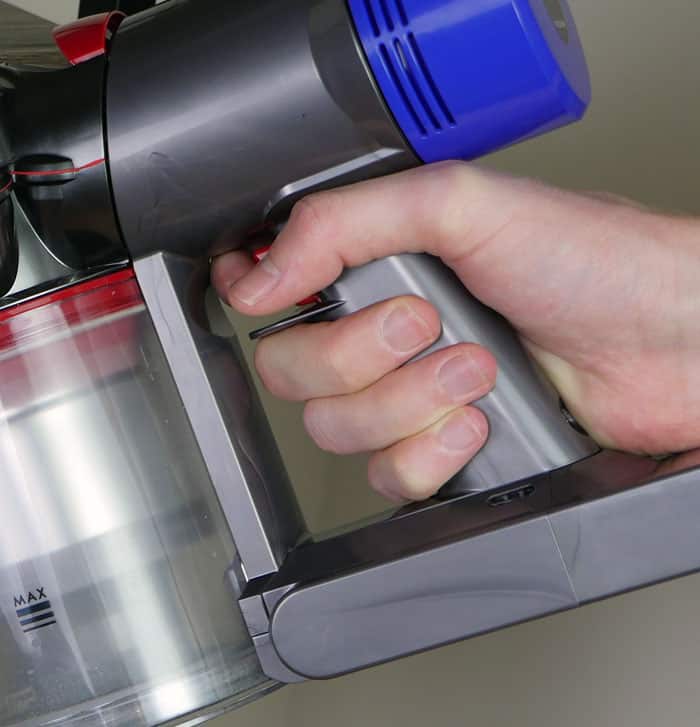
This design allows the battery to only be used when the trigger is being pulled.
2-in-1 Design
Both the Dyson V7 and V8 can be configured as a stick or handheld vacuum.
Inserting the wand results in creating a stick vacuum, but the wand can be removed quickly, turning the unit into a handheld vacuum. Each of these Dyson vacuums has a good level of versatility.
Emptying the Dust Bin
Unlike the rest of the V-series Dyson vacuums, the V7 and V8 are the only two that share an identical dust bin emptying process.

Both of these have a tab on top of the handheld portion of the unit. Users can pull that tab up and the dust bin flap on the bottom of the vacuum will open, allowing users to hold the unit V7 and V8 directly above the trash can while emptying.

More Dyson Vacuum Comparisons
Looking for more Dyson comparisons? See our complete list below:
- Dyson V6 vs. V10
- Dyson V6 vs. V7
- Dyson V6 vs. V7 vs. V8 vs. V10 vs. V11
- Dyson V6 vs. V8
- Dyson V7 vs. V10
- Dyson V7 vs. V8
- Dyson V7 vs. V11
- Dyson V8 vs. V10
- Dyson V8 vs. V11
- Dyson V10 vs. V11
- Dyson V7 vs. V11
- Dyson V8 vs. V11
- Dyson V11 Torque Drive vs. Outsize vs. Animal vs. Outsize Origin
Maneuverability Differences
Once again, the Dyson V7 and V8 are similar in terms of maneuverability.
Portability
The V8 weighs just under half of a pound more than the V7. Therefore, there is not much of a difference when it comes to pushing these vacuums around, or using them as a handheld vacuum.
Cleaning Angle
When it comes to the angles at which the V7 and V8 can turn or lay flat without lifting up (when assembled as a stick vacuum), they are virtually identical.
Both of these Dyson models have the ability to lie almost completely flat on the ground before the head of the vacuum starts to lift off of the ground.

In addition, each of these is able to make sharp turns of 90°.
Both the Dyson V7 and V8 can turn ultra tight 90° turns, are lightweight, and can lay nearly flat.
Maintenance Costs
Maintaining each of these vacuums is easy. The main tasks consist of emptying the dust bin, washing / replacing the filters (if needed), and replacing the battery after it dies.
| Part | Replacement Frequency | Dyson V7 | Dyson V8 |
|---|---|---|---|
| Central Filter | Only if damaged or lost | Check Price | Check Price |
| HEPA Filter | Only if damaged or lost | Check Price | Check Price |
| Battery | ~24-60 months | Check Price | Check Price |
Emptying the dust bin should be completed after every major cleaning cycle. Washing the primary filter can be completed every few cleaning cycles and only needs to be replaced if lost or damaged. This goes for the HEPA filter as well.
The battery should last at least the life of the warranty, and could even go as long as 5 years. If it does die within the warranty time frame (2 years), Dyson will replace it at no cost to you.
Dyson V7 annual maintenance costs is estimated to be around $9.50 / year and Dyson V8 annual maintenance costs should be around $11.25 / year.
The annual maintenance costs above reflect replacing the battery every 4 years. Either way, this cost wouldn’t begin until after the warranty expires.
Dyson notes that its filters are lifetime washable filters. Therefore, you do not need to replace a filter on either of these Dyson vacuums unless you lose or damage one.
RELATED – Cordless vacuums make mobility significantly easier. See some of the best cordless handheld vacuums here, as well as other cordless stick vacs we like, including the Dyson V10 and Shark Vertex DuoClean.
Does the V7 or V8 Have a Better Battery?
The Dyson V7 and V8 have a similar battery, but the V8 offers a longer run time. Although they both come with lithium-ion batteries, the V8 has a slightly larger power capacity, coming in at 2,800 mAh as compared to the V7’s 2,100 mAh.
That beign said, the V7 has the lower sticker price.
| Part | Dyson V7 | Dyson V8 |
|---|---|---|
| Capacity | 2,100 mAh | 2,800 mAh |
| Charging Time | 3.5 hours | 5 hours |
| Run Time | ~30 minutes* | ~40 minutes* |
| Replacement Cost | Check Price | Check Price |
The run time of the V8 lasts about 40 minutes, which is an additional 10 minutes compared to the V7.
That said, if you switch either of these vacuums into “MAX” power mode, you will see a significant drop in battery run time.
Is Dyson V7 or V8 Quieter?
When comparing noise, the Dyson V8 is a touch louder than the V7.

Measured from 3′ away, the V8 comes in around 73 dB and the V7 comes in at 70 dB.
Value Comparison
For the best value, let’s compare these two models.
Dyson V7 Value
All things considered, I would say the Dyson V7 has a solid value. The cleaning performance on hardwood floors did not stack up well against the V8, but the rest of the cleaning tests proved to be a breeze for the V7.

When it comes to design, these two vacuums are extremely similar.
Price fluctuates depending on the model of the V7 you purchase, but in general the V7 should be less than the V8.
- Warranty – 2 years
- Returns – Varies by retailer, other retailers may vary
- Check Price
Dyson V8 Value
The overall value of the Dyson V8 is hard to beat. Although this vacuum is priced higher than the V7, its cleaning performance is certainly an upgrade.
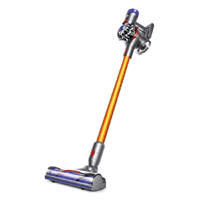
The V8 was able to clean up all four of our debris types on all three floor surfaces at the same, or higher, level than the V7.
In my opinion, the price of this Dyson vacuum justifies its performance and quality, giving it a slightly better value than the V7.
- Warranty – 2 years
- Returns – Varies by retailer, other retailers may vary
- Check Price
Dyson V7 vs. V8 Specifications
| Specs | Dyson V7 | Dyson V8 |
|---|---|---|
| Type | Stick | Stick |
| Manufacturer | Dyson | Dyson |
| Model | V7 | V8 |
| Length | 49" | 49.2" |
| Width | 9.8" | 9.8" |
| Depth | 8.2" | 8.8" |
| Weight | 5.45 lbs. | 5.75 lbs. |
| Floor Type | All (indoor) | All (indoor) |
| Dustbin Capacity | 0.4 L | 0.54 L |
| Cordless | Yes | Yes |
| Bagless | Yes | Yes |
| Returns | Varies by retailer | Varies by retailer |
| Warranty | 2 Year limited | 2 Year limited |
| Buy | Check Price | Check Price |
Biggest Differences of Dyson V7 vs. V8
1. Battery Power
The Dyson V8 has a larger capacity battery (2,800 mAh vs. V7’s 2,200) and is able to run for 40 minutes (10 minutes longer than the V7).
2. Cleaning Performance
The Dyson V8 dominated the V7 on hard floor cleaning tests, especially rice and cereal. The V7’s cleaning head design had a tendency to fling rice around and was too close to the ground (preventing it from getting over the top of larger debris, like cereal).
3. Annual Maintenance
The Dyson V7 only costs around $9.50 / year to maintain, compared to the V8’s $11.25 / year. The cost difference is due to the battery, which is more expensive on the V8 if you need to replace.
Should You Buy the Dyson V7?
The Dyson V7 is an older model, but still a well rounded vacuum cleaner. The battery and motor are still some of the best performers, helping to create a Dyson stick vacuum worth considering.
You should buy the Dyson V7 if you…
- Want a lower cost unit – The price difference is not huge, but the V7 is the less expensive model between the two. There are also four models to choose from, all of which are less expensive compared to the V8.
- Don’t need the longer run time – The Dyson V7 offers about 30 minutes of run time, which comes in around 10 minutes shorter than the V8. This is still a great amount of time, but if you need more time to vacuum your home then this may not be the right choice.
See here for more information or to buy the Dyson V7.
Should You Buy the Dyson V8?
The Dyson V8 has a larger capacity battery, longer run time, greater cleaning performance, and a larger dust bin. It is objectively better in virtually every criteria compared to the V7. However, it’s also more expensive. But with price comes performance.
You should buy the Dyson V8 if you…
- Want a longer run time – The V8 has the ability to run for ~40 minutes when fully charged. This extra time (compared to the 30 minute run time on the V7) could be the difference between finishing the job and not.
- Want a stronger cleaning performance – Overall, the V8 had a stronger cleaning performance than the V7. When on carpets, these two vacuums performed on a similar level. Yet, when it came to hardwood floors, the V8 took a strong lead over the V7.
- Want a larger dust bin – The V8’s dust bin is around 30% larger than the V7 (0.54 L compared to 0.4 L)
See here for more information or to buy the Dyson V8.
Updates
- March 3, 2021 – Added a run test tests section. Improved formatting. Clarified a few points, opinions, and facts. Fact checked the comparison. Updated several outdated links. Updated the estimated annual maintience costs.
- April 16, 2019 – Improved formatting and layout in several sections. Added new internal links. Removed some redundant information.
- March 31, 2019 – Comprehensive page re-design.
